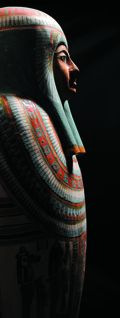Life under wraps
On display for nine decades, the coffin of a 2,800-year-old Egyptian mummy has never been opened. But CT imagery peeled away paint, plaster, and linen to reveal the woman inside.
By Lydialyle Gibson
Coffin photograph by Dan Dry
CT photograph by Anna Ressman
 On January 25, 1920, Oriental Institute founder James Henry Breasted, traveling Egypt in search of antiquities and excavation sites, wrote a letter to his wife, Frances, at home in Hyde Park. “Just as I was leaving Luxor,” he told her, “old Mohammed Mohasseb sent his son to see me and tell me he had something to show me. After many precautions and much secrecy, the son took me into the court of a house where lay a beautifully colored white and red mummification coffin, as fresh and bright as the day it left the painter’s studio.”
On January 25, 1920, Oriental Institute founder James Henry Breasted, traveling Egypt in search of antiquities and excavation sites, wrote a letter to his wife, Frances, at home in Hyde Park. “Just as I was leaving Luxor,” he told her, “old Mohammed Mohasseb sent his son to see me and tell me he had something to show me. After many precautions and much secrecy, the son took me into the court of a house where lay a beautifully colored white and red mummification coffin, as fresh and bright as the day it left the painter’s studio.”
Inside was the mummy of Meresamun (view the interactive feature), a woman who lived nearly 3,000 years ago in the ancient city of Thebes, where Luxor stands now. For 330 Egyptian pounds (nearly $17,000 in today’s dollars), Breasted bought the coffin and another artifact and hauled them back to Chicago, where they became part of the Oriental Institute’s nascent collection. The coffin was never unsealed, because doing so would destroy it, but OI scholars gleaned what they could from its exterior. The lavish decoration—painted flower garlands, winged serpents, wedjat eyes, suns, falcons, jackals, gods wrapped as mummies—located the coffin in time and place, and a ribbon of hieroglyphics provided Meresamun’s name and occupation: Singer in the Interior of the Temple of Amun. “Her job,” says Egyptologist Emily Teeter, PhD’90, “was to make music for the god.” Meresamun stood near the top of an elaborate bureaucracy of singers, dancers, and priestesses in Thebes’s sprawling Karnak Temple. She was one of only a few allowed into the deep sanctuary where Amun, in the form of a statue, ate, slept, and received offerings from Karnak’s priests.
Twenty years ago OI researchers began trying to peer inside Meresamun’s coffin, first with x-rays and then with computed tomography (CT). Those early scans revealed that she died young, at perhaps 30 years old, but many images remained unclear. “CT machines back then were like horse and buggy,” Teeter says. Then this past September the Medical Center received a new, 256-channel, “intelligent” CT scanner, so Teeter and a team of OI researchers strapped the coffin to a gurney and wheeled it in. Remarkable details emerged.

This past September the Medical Center received a new, 256-channel "intelligent" CT scanner, so Teeter and a team of OI researchers strapped the coffin to a gurney and wheeled it in. Remarkable details emerged.
Radiologist Michael Vannier found subtle spurs in her spine—normal for her age—and teeth so worn they were almost concave. A broken jaw that in a 1991 scan looked like a traumatic injury was actually, Vannier saw, damage from a dropped coffin. “We first went into the CT,” Teeter says, “as a way to find out if what we assumed about her life from the style of her expensive coffin and her elite title would be borne out by the scan.” It was. Meresamun’s remains attest to the robust health of an affluent woman.
Through December 6, Meresamun is the focus of an OI exhibit bringing together the CT images and 71 artifacts from the museum’s collection to illuminate her life story, and by extension, the stories of other Egyptian women from around 800 bc. The exhibit includes a sistrum, a bronze rattle like the one Meresamun would have used, and a relief fragment showing a sistrum player’s outstretched arm. Among the other artifacts: a pair of copper tweezers, a magic knife to protect women and children from evil, stone stelae for at-home worship, and figurines of women at work grinding grain and mashing beer. Legal records demonstrate the equality ancient Egyptian society offered women, who could inherit property and initiate divorce, sue and be sued. “We look at the ancient world,” Teeter says, “and the sound and the odor are gone, but the color and the architecture live on.”
WRITE THE EDITOR
DISCUSS THIS ARTICLE
E-MAIL THIS ARTICLE
SHARE THIS ARTICLE
WEB EXTRAS
Meresamun: A Life in Layers
Peel away the plaster coffin layer by layer to learn about Meresamun's life from Medical Center radiologist Michael Vannier and Oriental Institute Egyptologist Emily Teeter, PhD'90.

